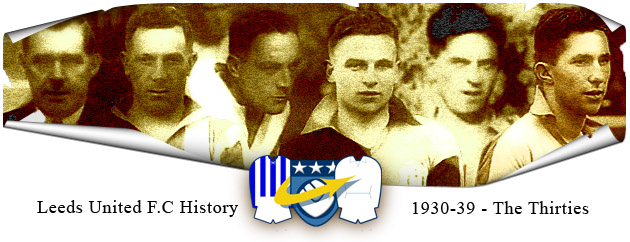
The Yo-Yo Team: The Thirties
| 1930-31: | Leeds Stats: Season Statistics: Games, Results, Appearances, Goalscorers and Teamsheets Season Statistics: Games, Results, Appearances, Goalscorers Football League Tables for the Season |
After hopes had been raised of a serious tilt at the title, United inexplicably slid into Division 2 at the end of the 1930/31 season.
Not for the first time, the club were beset by financial problems and the £2,500 received from Hearts for the return of the now 33 year-old John White was used to settle debts rather than buy any replacements. George Reed had picked up a bad knee injury and so United featured the legendary Edwards, Hart, Copping half back line for the first time. It was the most feared of the day, with all three winning England honours. Reed could not regain his place and left for Plymouth Argyle along with full-back Harry Roberts who had been similarly displaced by Jack Milburn. Energetic Billy Furness emerged as John White’s replacement. He scored twice in United’s record 7-3 away win at Blackpool. There was a spectacular 7-0 home win over Middlesbrough and a struggling Manchester United were thumped 5-0, but otherwise there was little to cheer.
The defence was unreliable and the attack blew hot and cold, capable of brilliance in one match and infuriating inaccuracy the next. The team went into their final match needing to beat Derby County by at least a two-goal margin, while praying that Blackpool lost at Maine Road.
United obtained their immediate objective with a 3-1 victory, but Blackpool fought back from behind to snatch a late draw and win the point which sent Leeds tumbling into the Second Division. The Sea-siders had escaped despite a staggering total of 125 goals against, the highest total conceded by any club that managed to stay up. To compound their anguish they could look back to their 7-3 win at Bloomfield Road that season – the only time that Leeds have ever scored seven League goals away from home, but all to no avail. They finished in 21st place with 31 points.
Charlie Keetley led the goal-scoring with 16 in the league, followed by Wainscoat 12, Turnbull 11 and Furness 8, with Wainscoat and Furness each getting a couple in the Cup, which for once saw United make progress with home wins over Huddersfield Town 2-0 and Newcastle United 4-1 before falling at lowly Exeter City in the Fifth Round.
The Huddersfield tie had provided United with the first win over the lofty Town since joining the league at the 13th attempt. Charlie Keetley was injured and young Arthur Hydes was given his chance in preference to Tom Jennings, who immediately slapped in a transfer request. He scored and Jennings together with keeper Willie Johnson moved to Chester.
Jennings had played 167 league games and scored 112 goals, a record that was to stand until the incomparable John Charles arrived on the scene. He had remarkably been overlooked by Scotland, even though he had scored in a 1928 trial game.
There were further moves in the old guard when 33 year-old Russell Wainscoat, after 215 league games and 85 goals, moved to Hull City, who he led to a Third Division Championship in 1933. Left winger Tom Mitchell, now 32 left for York City, but Tom Cochrane had already established himself as first choice.
| 1931-32: | Leeds Stats: Season Statistics: Games, Results, Appearances, Goalscorers and Teamsheets Season Statistics: Games, Results, Appearances, Goalscorers Football League Tables for the Season |
Once again, in 1931/32, United bounced back at the first time of asking. Some of the old guard had moved on and Leeds’ strength now lay in their brilliant half-back line of Edwards, Hart and Copping. With no money available to strengthen the team United relied on the tried and true and a few emerging youngsters. Jimmy Potts still excelled in goal, while the ever-present Jack Milburn was partnered by the trusty Bill Menzies or his younger brother George. The Edwards-Hart-Copping combination was a class above any other half –back line in the Division. Harry Duggan had finally replaced Bobby Turnbull on the right-wing, with young Joe Firth at inside-right, Charlie Keetley at centre-forward, Billy Furness at inside-left and Tom Cochrane missing only one game on the left-wing.
The season was started with two away wins, but that was soon negated by two consecutive home defeats. This was followed by a remarkable nine straight wins, including the 5-2 thrashing of Manchester United at Old Trafford, as United took the Division by storm. Unfortunately a poor run-in with only two wins in their last 10 games saw United finish second with 54 points, two behind Wolves. They could have finished with the same number of points as the champions had they not lost their final game at home to Port Vale, who had to win to avoid relegation.
Charlie Keetley again led the goal-scorers with 23 with Joe Firth amassing 14 and Billy Furness 12.
In the Cup United again fell in the Third Round, this time 3-1 at Queens Park Rangers.
| 1932-33: | Leeds Stats: Season Statistics: Games, Results, Appearances, Goalscorers and Teamsheets Season Statistics: Games, Results, Appearances, Goalscorers Football League Tables for the Season |
After another year of financial loss, Dick Ray once more was unable to strengthen his team and had to rely on his promotion-winning team to carry the day. This they did to the extent that Billy Furness and Wilf Copping joined the expanding band of English Internationals, with the prolific Charlie Keetley also coming close, when picked as reserve for the Football League against the Irish League in Belfast. He earned that honour on the back of five goals in his first five games in the First Division.
The Milburn brothers were both ever-present at full-back, as was Billy Furness at inside-left. Unable to get a game at full-back, Bill Menzies moved on to Goole Town.
Hart and Copping starred for England, as well as each featuring 39 times for Leeds, and the half-back trio was still one of the best in the land. Arthur Hydes was making his mark and led the goal-scorers with 16 in 39 league games. While, the sometimes injured, Charlie Keetley had 14 from 24 appearances.
After losing their opening two games they lost only twice more in 1932. Top of the table Arsenal were in rampant mood and the dominant team of the era, which saw them win three consecutive titles. Former Leeds reserve player, Jack Lambert, had just scored five in the 9-2 thrashing of Sheffield United and a crowd of 55,876 turned up at Highbury on Boxing Day expecting to see United put to the sword. Two goals from Charlie Keetley gave United a famous 2-1 victory and set the scene for the return game at Elland Road the following day, when the visit of Arsenal pushed the attendance record up to 56,796. For safety reasons the gates were locked and hundreds clambering on nearby house roofs as well as the Peacock Public House and various vantage points on Beeston Hill, in an attempt to get a glimpse of the action. The record was to stand for 35 years. Victory would have strengthened United’s championship aspirations but they were held to a goal-less draw by the star-studded Gunners and then fell away badly in the second half of the season. They amassed 44 points to finish a very creditable eighth.
Dick Ray also pulled another rabbit out of the hat, when he signed the classy 17 year-old wing-half, Bert Sproston. He would later convert him to an England International Full-Back and one of United’s best ever.
At last there was a modicum of success in the FA Cup where they reached the Fifth Round for the first time. An Arthur Hyde hat-trick gave United an easy 3-0 passage at Newcastle United before a crowd of 47,554, while Tranmere Rovers were humbled 4-0 at Elland Round in the Fourth Round Replay after a goal-less draw at Tranmere. Another huge crowd of 58,073 was on hand at Goodison to see Everton put an end to United’s run, 2-0 in the Fifth Round.
| 1933-34: | Leeds Stats: Season Statistics: Games, Results, Appearances, Goalscorers and Teamsheets Season Statistics: Games, Results, Appearances, Goalscorers Football League Tables for the Season |
The fearless, one man tackling machine Wilf Copping was now cementing his status as the new star of the team with some stirring displays in his 39 appearances. Behind him Stan Moore had replaced Jimmy Potts in goal and was ever-present, while the full backs pairing of the Milburn brothers were equally reliable with Jack missing only one and George five. Up front Charlie Keetley suffered from injury and loss of form, which forced Dick Ray to revamp his attacking force. Harry Duggan took on the centre-forward role and reserves John Mahon and Joe Firth were pressed into service. However it was the absence through injury of the veteran talisman Willis Edwards which effected United most. It was no coincidence that the re-establishment of the Edwards-Hart-Copping triumvite, in early April, saw United set a new high-scoring record as Leicester were hammered 8-0 at Elland Road. Unfortunately it was a one-off in a frustrating injury ravaged season as United finished a respectable 9th with 42 points.
Arthur Hydes (16) and Harry Duggan (11) were the main goal-scorers. Keeper Stan Moore was the only ever-present, with Billy Furness and Tom Cochrane being absent only once. However Copping (38), George Milburn (37) with Duggan and Hart (33) being the only players to manage more than 20 appearances illustrated the extent of the injury problem.
Not unsurprisingly there was the usual 3rd Round FA Cup exit, by the only goal to Preston North End at Elland Road.
| 1934-35: | Leeds Stats: Season Statistics: Games, Results, Appearances, Goalscorers and Teamsheets Season Statistics: Games, Results, Appearances, Goalscorers Football League Tables for the Season |
Wilf Copping was allowed to join Arsenal for a sensational £6,000 and long-serving keeper Jimmy Potts moved to Port Vale. There were murmurs of disapproval as United crashed to a record 8-1 defeat, in the second game of the season at Stoke City, with Stanley Matthews scoring four. It was only seven games after United’s record 8-0 win over Leicester City.
In September, there was a change of strip from the blue and white striped shirts to blue and gold halved ones. White shorts and blue stockings with gold tops completed the new ensemble. It clearly did not impress Liverpool, as they handed United a 3-0 Elland Road drubbing to mark the occasion.
The popular prolific goal-scorer, Charlie Keetley, left for Bradford City in October, having scored a remarkable 108 league goals in just 160 games.
Arthur Hydes returned from injury, in the same month and finished leading scorer with 22. Billy Furness also weighed in with 16 and proved to be the star performer. He, unfortunately, suffered a broken collar bone in the cup defeat by Norwich City and missed the ensuing six league games.
United did manage to beat local rivals Huddersfield Town in a League game since first joining the Football League, 2-0 at Elland Road to end an unwanted 17-match sequence. This was the season’s only highlight as injuries once again dogged their progress. Dick Ray recruited veteran Scottish International centre-half Jock McDougall in November from Sunderland for £6,000 and he quickly fell to the injury jinx. Likewise the £1,150 acquisition from Newcastle United in February, centre-forward Jack Kelly was also laid low. Dick Ray, who had proved to be a frugal but successful Leeds Manager decided he could not take United further and resigned in early March. He was replaced by another former Leeds City old-boy, albeit a War-time guest, Billy Hampson.
Injuries apart, Dick Ray had left a reasonable squad of players with Willis Edwards and Jack Milburn still shoring up the defence, Billy Furness continued to shine and Tom Cochrane was proving to be a tricky left-winger. Probably more importantly, the young Bert Sproston was showing his class at right back and Eric Stephenson had shown his talents as deputy to the injured Billy Furness. Both were to become future England Internationals.
There was a further humiliation, 7-1 at Stamford Bridge to Chelsea, in early March but eventually United struggled to safety, finishing 18th with 38 points.
In the FA Cup they again flattered to deceive. A Third Round 4-1 home win over Second Division local rivals Bradford Park Avenue must have heartened the supporters, especially with the prospect of further advancement against the Third Division (South) opposition of Norwich City. After sharing six goals at Norwich, United inexplicably lost the replay 2-1 at Elland Road.
| 1935-36: | Leeds Stats: Season Statistics: Games, Results, Appearances, Goalscorers and Teamsheets Season Statistics: Games, Results, Appearances, Goalscorers Football League Tables for the Season |
Billy Hampson immediately opted for experience with men like 34 year-old Albert McInroy from Sunderland in goal and 32 year-old George Brown from Burnley in attack, both former England internationals. Brown arrived in September after United had failed to win any of their first five games and quickly struck up a scoring partnership with Jack Kelly. Brown finished top scorer with 18 in the league followed by Kelly with 15. Jack Milburn was deadly from the penalty spot as his howitzers produced nine goals.
Irishman Bobby Browne was signed in October from Derry City for £1,500 and was soon capped by Ireland. Cyril Hornsby, having lost his left-half position moved on to Sunderland.
November saw goals pour at Elland Road with Sheffield Wednesday hammered 7-2, after incredibly being 6-1 up at half-time, followed by a 5-2 victory over Bolton Wanderers.
Considering the aging team United were well satisfied to finish an improved 11th with 41 points.
In the FA Cup United survived a 1-1 trip to Molineux and then beat Wolves 3-1 in the Elland Road Replay. Second Division Bury were overcome 3-2 at home in the Fourth Round another Second Division team, Sheffield United, dismissed them 3-1 in the Fifth Round, in front of a Bramall Lane record crowd of 68,287.
| 1936-37: | Leeds Stats: Season Statistics: Games, Results, Appearances, Goalscorers and Teamsheets Season Statistics: Games, Results, Appearances, Goalscorers Football League Tables for the Season |
After finishing 11th in the previous season, no improvement was noticeable and in the drop was only just avoided as United finished 19th with 34 points, only 2 points above the relegation zone. Pitiful away form – only three points won on opponent’s grounds – put Leeds in danger and they hauled themselves to safety only after the signing of burly South African centre-forward, Gordon Hodgson, from Aston Villa. He notched 6 goals in 11 games to finish joint second leading goal-scorer with Eric Stephenson behind Arthur Hydes who topped the list with 11.
Ernie Hart managed only 4 games and joined Mansfield Town at the end of the season after being a model of consistency for 17 years. He had made 472 appearances which stood as the record until eclipsed by Grenville Hair in the early 60’s.
His long–term partner, Willis Edwards at 33 was still United’s star performer and was considered by many to still be an England Candidate. There was no doubt his influence had rubbed off on Bert Sproston, who gained his first England cap against Wales in October 1936. There were surprises in that month as George Brown left for Darlington, Tom Cochrane for Middlesbrough and Right-Winger Harry Duggan headed for Newport County. Cochrane had held the left wing berth for almost six years and Arthur Buckley was bought from Oldham Athletic for £2,500 to replace him. Sammy Armes stepped up from the reserves to take the vacant right wing spot. George Ainsley, signed from Sunderland just before Christmas. A young Aubrey Powell had made his debut on the right-wing and before he was able to show his true promise he broke his leg, so badly that he was written off by doctors. He later battled back to give Leeds many years service and was often capped by Wales as an inside right. South African born, England International, Gordon Hodgson was almost 34 when he was signed in March 1937 from Aston Villa for £1,500 He was a legend at Liverpool where he scored 233 goals in 258 League games and his United debut could not have been worse. He returned to Merseyside to take part in a 7-1 rout at Goodison Park, which must have been most displeasing to him although he did get the consolation goal. His robust style was well to the fore as United saved their First Division status with emphatic wins over Sunderland 3-0 and Portsmouth 3-1 in their two final home games.
There was the usual 3rd Round exit in the FA Cup, with a 4-0 thrashing at Stamford Bridge by Chelsea.
There were bright spots as Sproston and Stephenson were now firmly established top performers. Powell and Ames had justified their elevation to the first team and George Milburn had led the reserves to their first and only Central League Championship. That team contained the young Tom Holley and Ken Gadsby. So the future did not look so bleak.
| 1937-38: | Leeds Stats: Season Statistics: Games, Results, Appearances, Goalscorers and Teamsheets Season Statistics: Games, Results, Appearances, Goalscorers Football League Tables for the Season |
There was a sweeping out of the older players in the close season. Centre-Half Jock McDougall retired, keeper Albert McInroy moved to Gateshead, the emergence of Eric Stephenson allowed Billy Furness to be sold to Norwich City for £2,700, while George Milburn joined his brother Stan at Chesterfield. Manager Hampson opted not to spend money on replacements electing to give some of the young reserves a chance. Willis Edwards was now semi-retired and took an active part in the coaching of the players and James Makinson took the chance to make the right-half position virtually his own, while Sammy Armes and Arthur Buckley consolidated their positions on the flanks.
Veteran Gordon Hodgson, the former Liverpool and England star, scored many of the goals that put Leeds up amongst the title challengers early in the season, and they were running a close second to Brentford after the Christmas games, but a dismal run beginning in February dashed their championship dreams as they faltered to 9th position with 43 points.
The season was saved from total anti-climax by the arrival of two young Irish stars. Goalkeeper Jim Twomey, and teenage Right-Wing sensation David Cochrane. Though only 17, Cochrane commanded a £2,000 fee, which was fully justified by his precocious talent which saw him capped by Ireland soon afterwards. Twomey also attracted the Irish selectors’ attention and he too, was quickly capped.
Arthur Hydes was dogged by injury and did not feature once in the whole season and was allowed to depart for Newport County at the season’s end, having scored 82 goals in 137 appearances. Hodgson powered 25 goals in 36 matches and Jack Kelly was allowed to join Birmingham City midway through the season.
The high league position was attained with a very settled squad of Reg Savage; Bert Sproston, Jack Milburn; James Makinson, Tom Holley, Bobby Browne; Sammy Armes, George Ainsley, Gordon Hodgson, Eric Stephenson and Arthur Buckley. While only Jack Milburn was ever-present, most of the team featured in the high 30’s in appearances
In the FA Cup there was a 3-1 home victory in the Third Round over Third Division Chester City, before they narrowly lost 2-1 at the Valley to fourth placed Charlton Athletic, in the 4th Round.
| 1938-39: | Leeds Stats: Season Statistics: Games, Results, Appearances, Goalscorers and Teamsheets Season Statistics: Games, Results, Appearances, Goalscorers Football League Tables for the Season |
Tottenham made a bid for Bert Sproston and United’s prize asset was allowed to leave for a near record £9,500. Hardly any of the fee was available for team building and Hampson merely moved Jack Milburn to Right-Back and brought in promising reserve Ken Gadsby on the left.
Hodgson, now 34 went into his 14th season and showed he had not lost his appetite for goals, rattling in a United record 5 goals in the 8-2 thrashing of Leicester City. That record still stands to this day.
David Cochrane and Jack Hargreaves were given the wing spots and were both instant successes, and with Aubrey Powell defying medical advice and making a welcome return at Inside-Right, United also made a good start to the last full season before World War Two. In November 1938, they held third spot. Unfortunately they again ran out of steam and slipped to a mid-table position of 13th with 41 points.
Jack Milburn lost his Right-Back berth to Leeds-born schoolboy International Les Goldberg and joined Billy Furness at Norwich City in March 1939, but this news was overshadowed by the return of Wilf Copping to add backbone to an over-generous defence. Ken Gadsby and George Ainsley were both selected for the FA XI for the tour of South Africa and though they featured in the “tests” they did not qualify as full Internationals.
Third Division Bournemouth was duly beat at home in the Third Round of the FA Cup, but United were unable to beat local rivals Huddersfield Town at the same venue in the 4th Round going down 4-2.
| 1939-40: | Leeds Stats: Season Statistics: Games, Results, Appearances, Goalscorers and Teamsheets Season Statistics: Games, Results, Appearances, Goalscorers Football League Tables for the Season |
Leeds was rock bottom with only 1 point from the three games when the 1939/40 season was aborted. They did not even manage a goal as they drew 0-0 at Preston North End, and at home lost 1-0 to both Charlton Athletic and newly promoted Sheffield United. The last game saw the debut of a third Milburn, Left-Back Jim, who was to serve United well until the advent of Grenville Hair in the early 50’s.
Photographs of the era:
Teams:
1930

1930-31
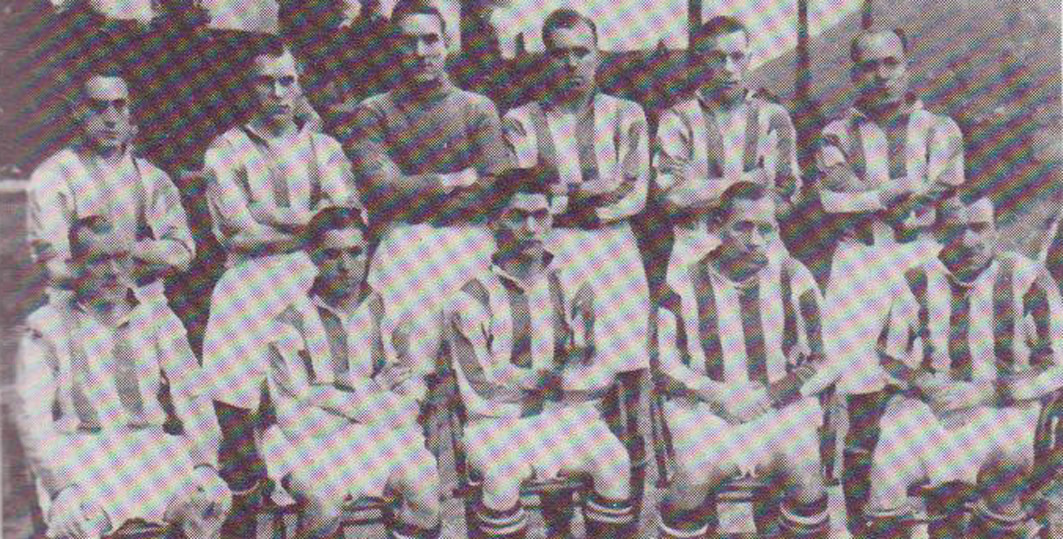
Back Row: Wilf Copping, George Milburn, Jimmy Potts, Ernie Hart, Jack Milburn, Willis Edwards.
Front Row: Bobby Turnbull, Billy Furness, Charlie Keetley, Russell Wainscoat, Tom Mitchell.
1931-32
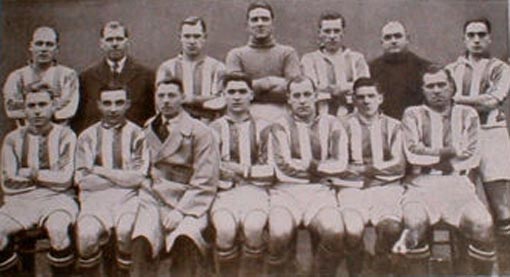
Back Row: Willis Edwards, Dick Ray (Manager), George Milburn, Jimmy Potts, Jack Milburn, Arthur Campey (Trainer), Wilf Copping.
Front Row: Harry Green, Joe Firth, Bill Menzies, Charlie Keetley, Russell Wainscoat, Tom Cochrane, Ernie Hart.
1931-32
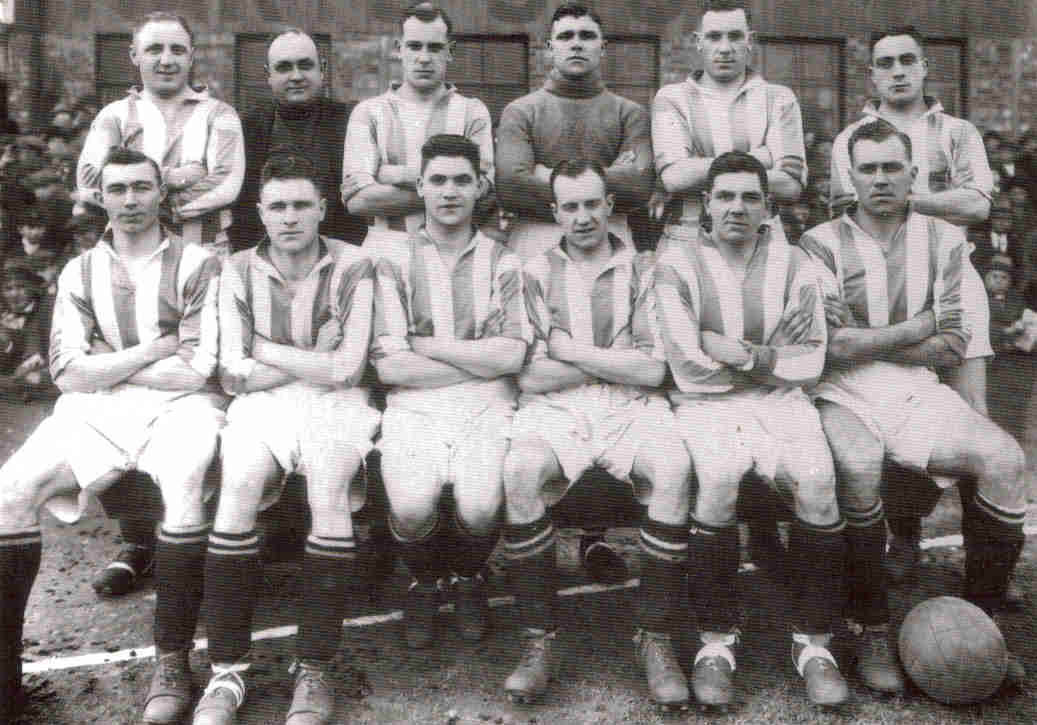
Back Row: Alex Stacey, Arthur Campey (Trainer), George Milburn, Stan Moore, Jack Milburn,Wilf Copping.
Front Row: Harry Duggan, Cyril Hornby, Charlie Keetley, Willie Bennett, Tom Cochrane, Ernie Hart.
1931-32(Courtesy of Paul Gregson)
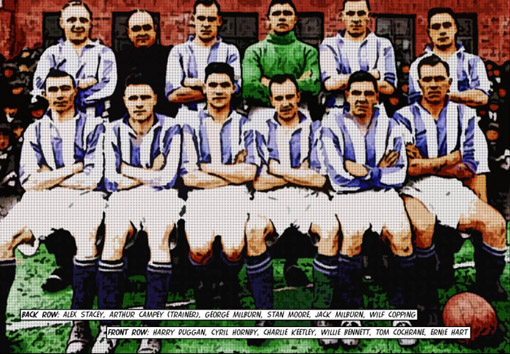
Back Row: Alex Stacey, Arthur Campey (Trainer), George Milburn, Stan Moore, Jack Milburn,Wilf Copping.
Front Row: Harry Duggan, Cyril Hornby, Charlie Keetley, Willie Bennett, Tom Cochrane, Ernie Hart.
1932-33
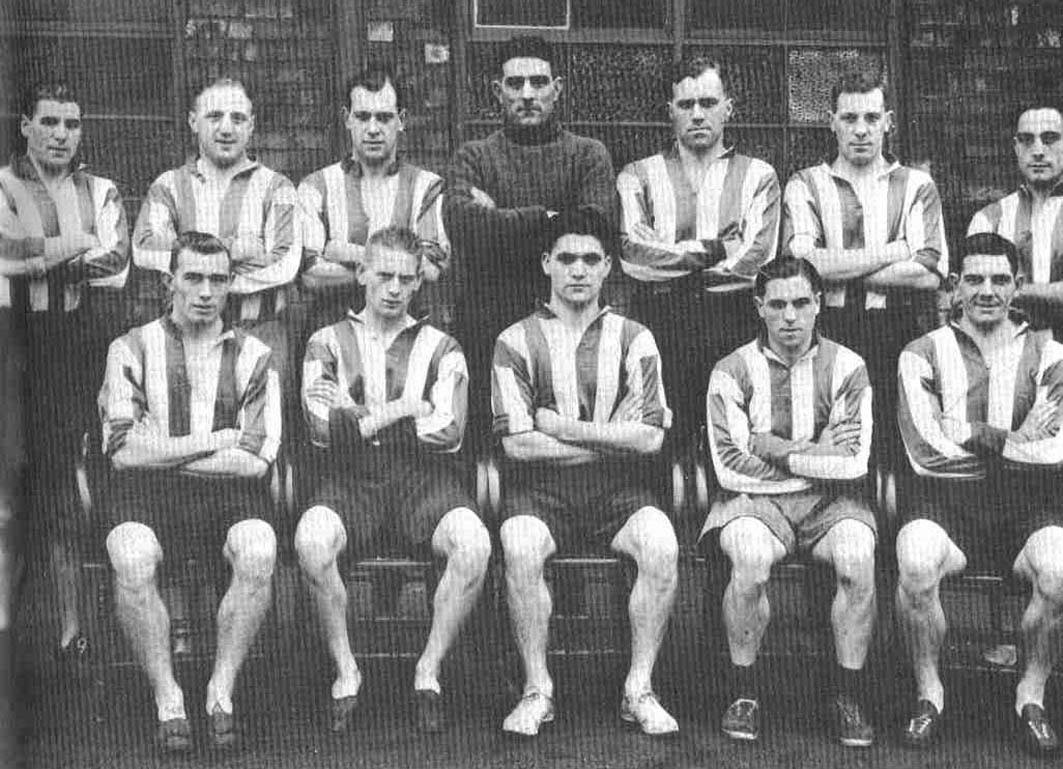
Back Row: Harry O'Grady, Alex Stacey, George Milburn, Jimmy Potts, Ernie Hart, Jack Milburn, Wilf Copping.
Front Row: Harry Duggan, Arthur Hydes, Charlie Keetley, Billy Furness, Tom Cochrane.
1932-33(Courtesy of Paul Gregson)
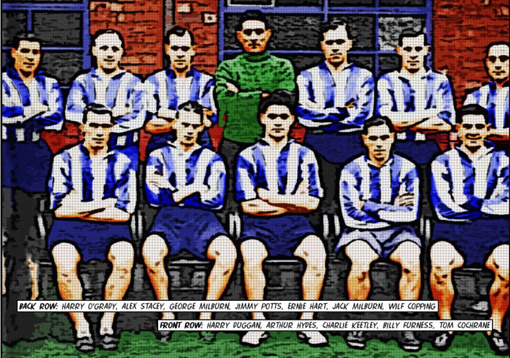
Back Row: Harry O'Grady, Alex Stacey, George Milburn, Jimmy Potts, Ernie Hart, Jack Milburn, Wilf Copping.
Front Row: Harry Duggan, Arthur Hydes, Charlie Keetley, Billy Furness, Tom Cochrane.
1932-33

Back Row: Alex Stacey, George Milburn, Jimmy Potts, Jack Milburn, Wilf Copping, Tom Neal.
Front Row: Harry Duggan, Tom Cochrane, Ernie Hart, Charlie Keetley, Billy Furness, Arthur Hydes.
1933-34
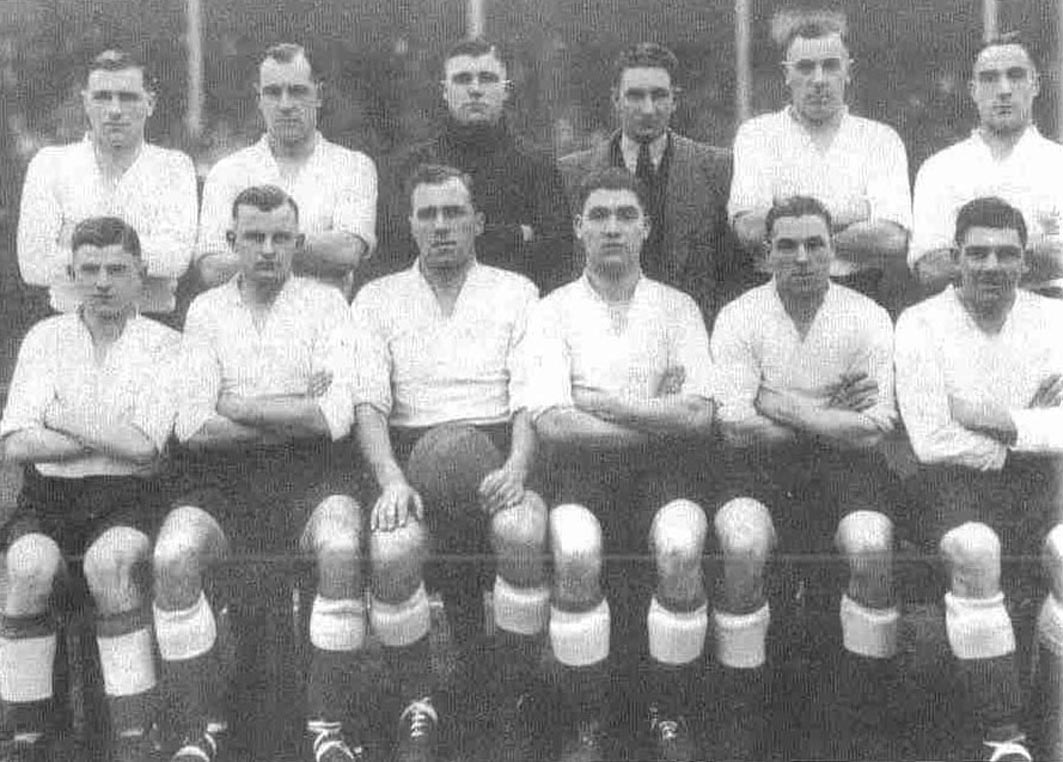
Back Row: Cyril Hornby, George Milburn, Stan Moore, Fred Jones, Jack Milburn, Wilf Copping.
Front Row: Jack Mahon, Harry Roper, Ernie Hart, Charlie Keetley, Billy Furness, Tom Cochrane.
1933-34(Courtesy of Paul Gregson)

Back Row: Cyril Hornby, George Milburn, Stan Moore, Fred Jones, Jack Milburn, Wilf Copping.
Front Row: Jack Mahon, Harry Roper, Ernie Hart, Charlie Keetley, Billy Furness, Tom Cochrane.
1933-34

1934-35
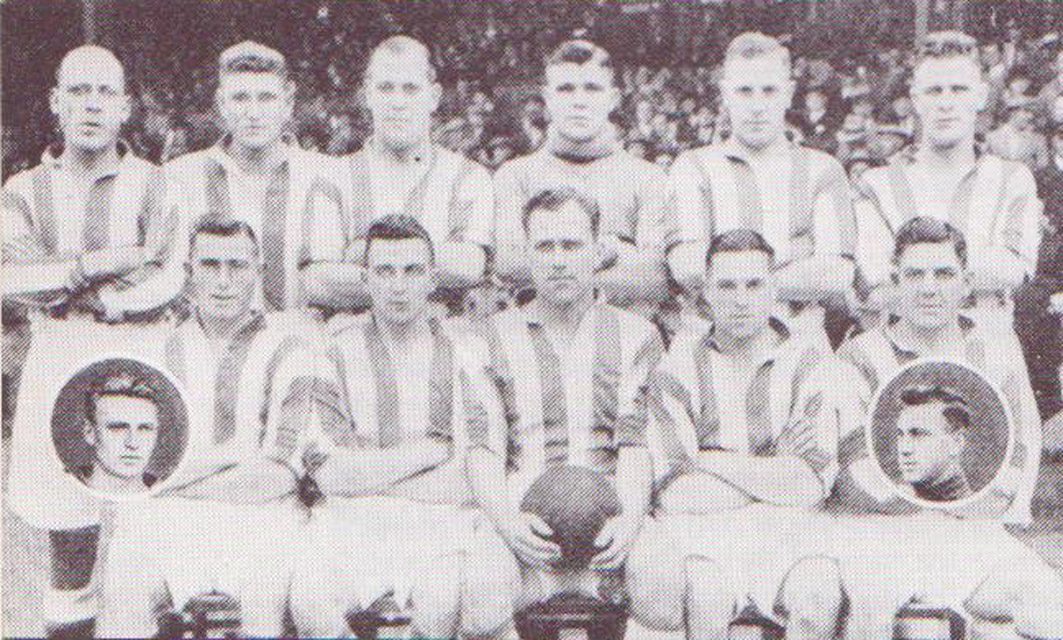
Back Row: Willis Edwards, Fred Mills, George Milburn, Stan Moore, Jack Milburn, Cyril Hornby.
Front Row: Harry Duggan, Joe Firth, Ernie Hart, Billy Furness, Tom Cochrane.
Inset: Bert Sproston, Reg Savage.
1934-35(Courtesy of Paul Gregson)
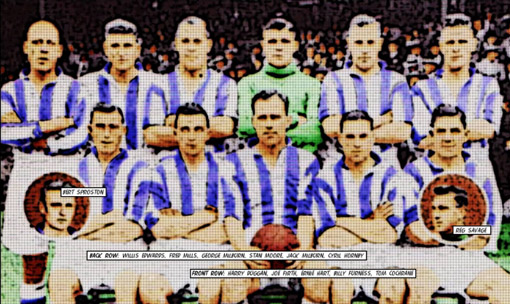
Back Row: Willis Edwards, Fred Mills, George Milburn, Stan Moore, Jack Milburn, Cyril Hornby.
Front Row: Harry Duggan, Joe Firth, Ernie Hart, Billy Furness, Tom Cochrane.
Inset: Bert Sproston, Reg Savage.
1934-35 (Courtesy Mark Ledgard)
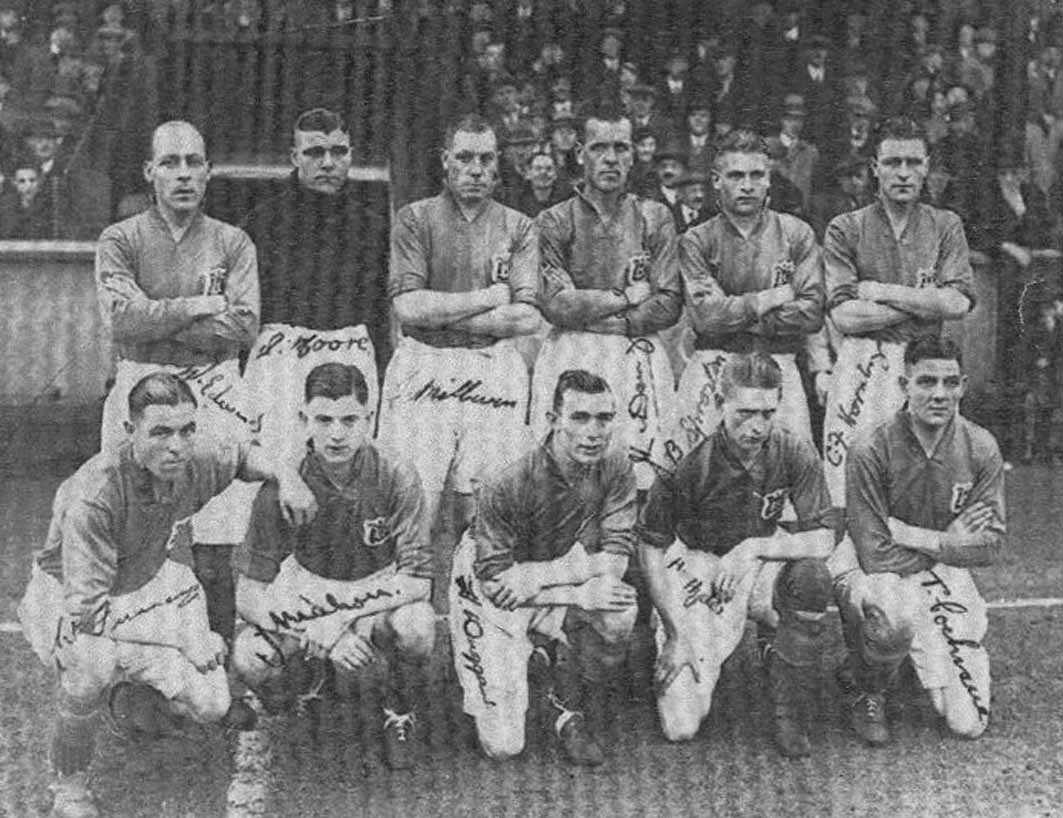
Back Row: Willis Edwards, Stan Moore, Jack Milburn, Jock McDougall, Bert Sproston, Cyril Hornby.
Front Row: Billy Furness, Jack Mahon, Harry Duggan, Arthur Hydes, Tom Cochrane.
1934-35 (Courtesy Mark Ledgard)
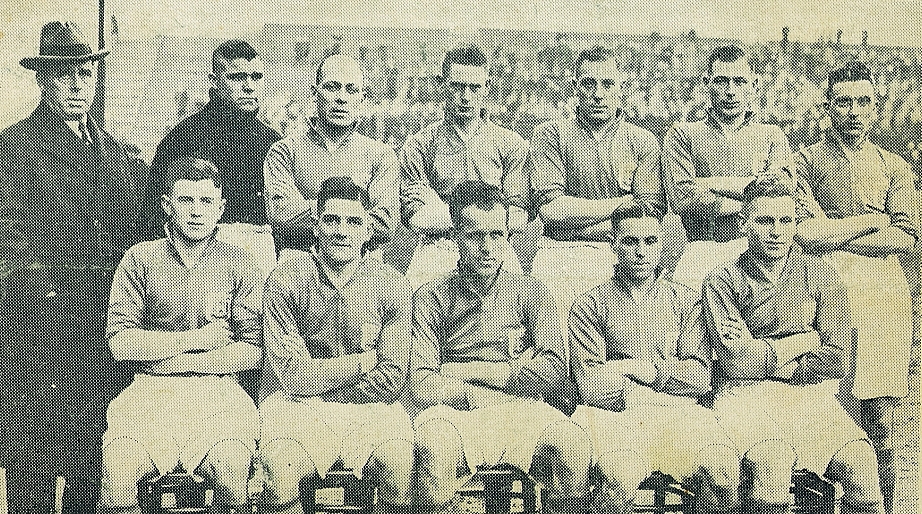
Back Row: Dick Ray (Manager), Stan Moore, Willis Edwards, Arthur Hydes, Jack Milburn, Tom Neal, Joe Firth.
Front Row: Jack Mahon, Tom Cochrane, Jock McDougall, Billy Furness, Bert Sproston.
1934-35: At Birmingham 22nd April 1935

Back Row: George Milburn, Jock McDougall, Tom Neal, Reg Savage, Jack Milburn, Cyril Hornby.
Front Row: Harry Duggan, Willis Edwards, Arthur Hydes, Ernie Hart, Billy Furness, Tom Cochrane.
1935-36
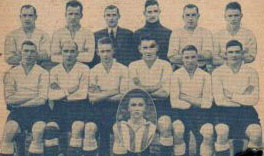
Back Row: George Milburn, Jock McDougall, Jack Kelly, Albert McInroy, Jack Milburn, Cyril Hornby.
Front Row: Harry Duggan, Willis Edwards, Arthur Hydes, George Brown, Billy Furness, Tom Cochrane.
Inset: Bert Sproston.
1935-36

Back Row: Bert Sproston, Willis Edwards, Jock McDougall, Albert McInroy, Jack Milburn, Cyril Hornby.
Front Row: Harry Duggan, Eric Stephenson, Arthur Hydes, Billy Furness, Tom Cochrane.
1935-36
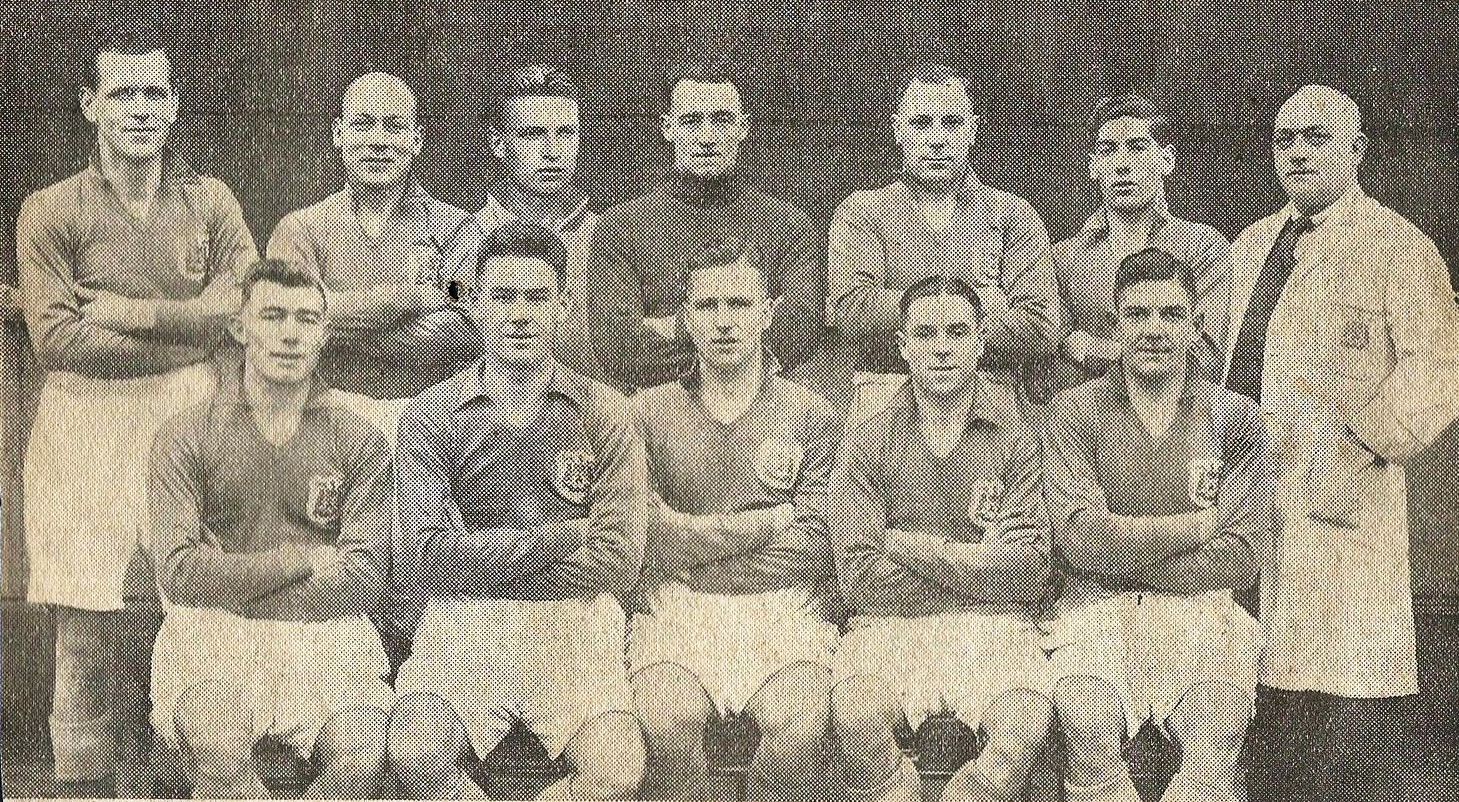
Back Row: Jock McDougall, Willis Edwards, Bert Sproston, Albert McInroy, Jack Milburn, Bobby Browne, Arthur Campey (Trainer).
Front Row: Harry Duggan, George Brown, Jack Kelly, Billy Furness, Tom Cochrane.
1935-36: At West Bromwich Albion 19th February 1936
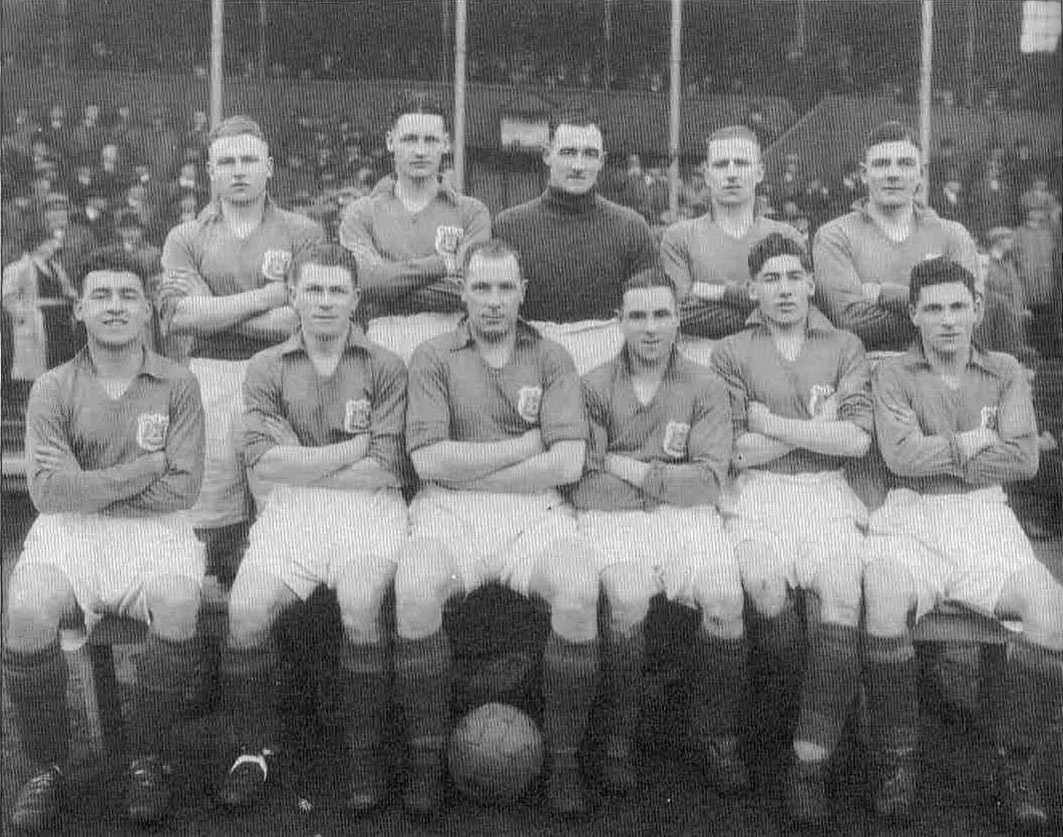
Back Row: Bert Sproston, Bob Kane, Albert McInroy, Jack Kelly, Tom Cochrane.
Front Row: Jim Makinson, Sammy Armes, Jack Milburn, Billy Furness, Bobby Browne, Eric Stephenson.
1935-36(Courtesy of Paul Gregson)
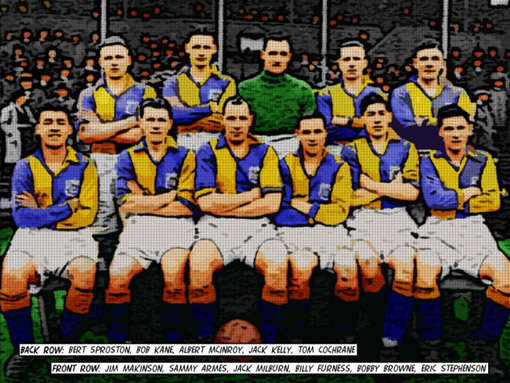
Back Row: Bert Sproston, Bob Kane, Albert McInroy, Jack Kelly, Tom Cochrane.
Front Row: Jim Makinson, Sammy Armes, Jack Milburn, Billy Furness, Bobby Browne, Eric Stephenson.
1935-36: Forwards
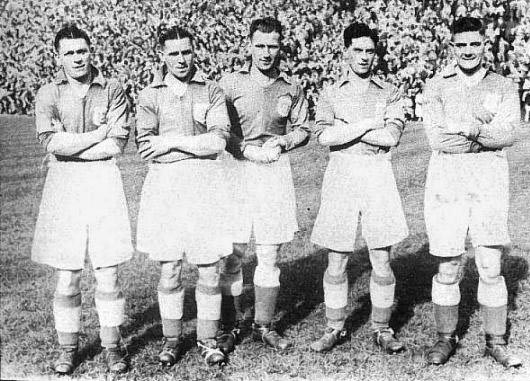
Sammy Armes, Billy Furness, Jack Kelly, Eric Stephenson, Tom Cochrane.
1936-37

Back Row: Willis Edwards, Bert Sproston, Albert McInroy, George Milburn, Jack Milburn, Bobby Browne.
Front Row: Sammy Armes, Eric Stephenson, Jock McDougall, Arthur Hydes, Billy Furness, Arthur Buckley.
1936-37(Courtesy of Paul Gregson)
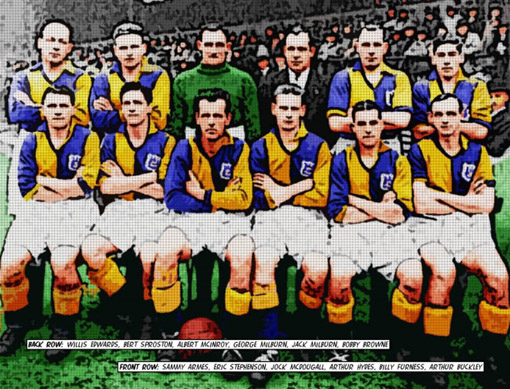
Back Row: Willis Edwards, Bert Sproston, Albert McInroy, George Milburn, Jack Milburn, Bobby Browne.
Front Row: Sammy Armes, Eric Stephenson, Jock McDougall, Arthur Hydes, Billy Furness, Arthur Buckley.
1936-37
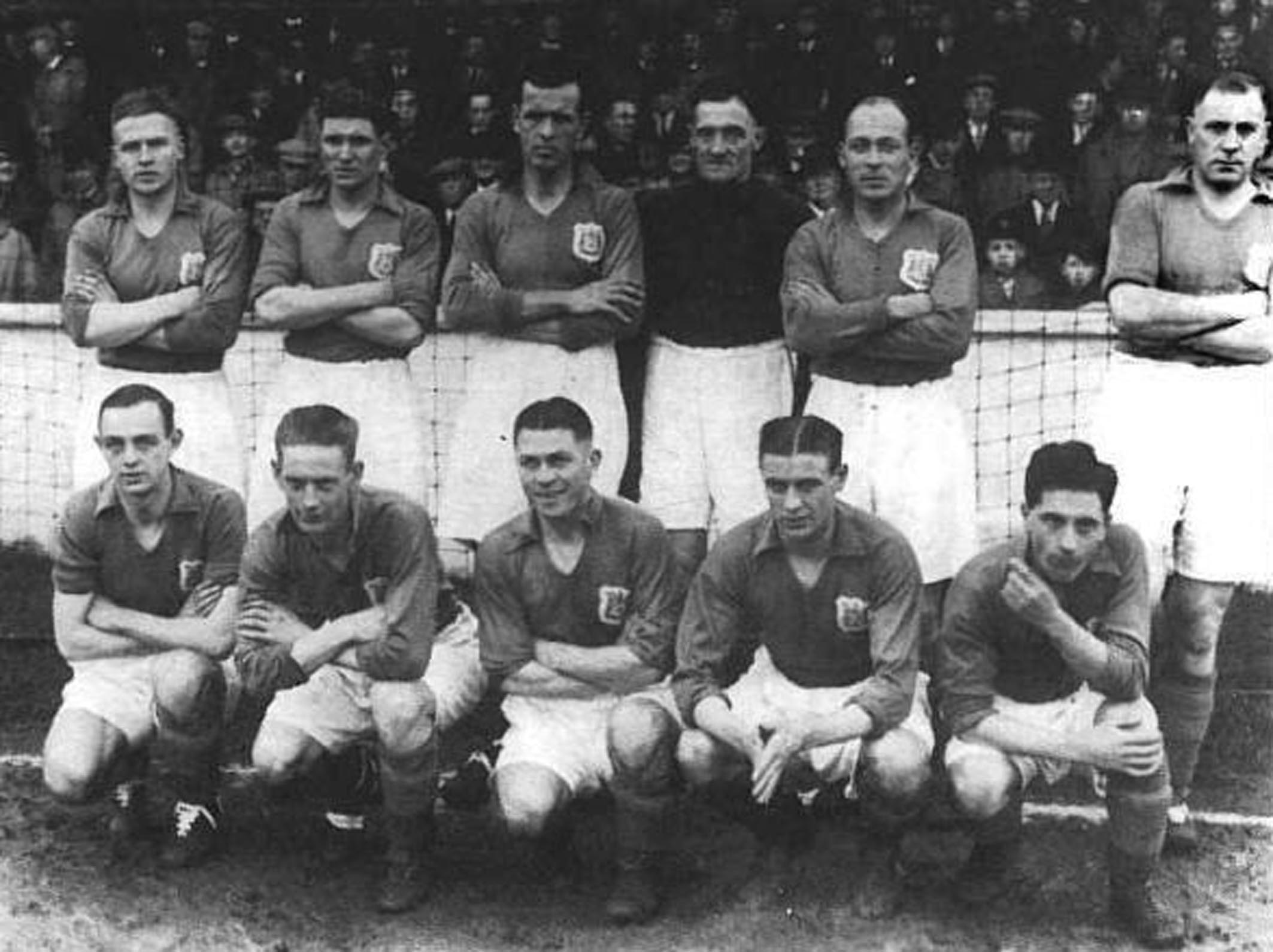
Back Row: Bert Sproston, Fred Mills, Jock McDougall, Albert McInroy, Willis Edwards, Jack Milburn.
Front Row: Arthur Buckley, Arthur Hydes, Sammy Armes, John Thomson, Eric Stephenson.
1937-38
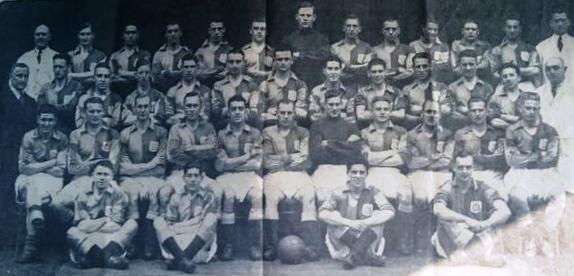
Back Row: F. Hopkin (Assistant Trainer), Harry Vickers, Jimmy Milburn, Cliff Francis, J.T. Hatton, Gerry Henry, W. Thompson, F. Ibbotson, Leslie Thompson, John Turner, John Thomson, Jackie Hargreaves, Bob Roxburgh (Assistant Trainer) .
Standing: Billy Hampson (Manager), Bob Kane, Jimmy Carr, Tom Hampson, Ken Gadsby, George Scaife, Dominic Kelly, Les Goldberg, Arnold Knight, Jack Trainor, John Short, Aubrey Powell, Arthur Campey (Trainer).
Sitting: Fred Mills, Tom Holley, George Ainsley, Gordon Hodgson, Jim Makinson, Jack Milburn, Reg Savage, Bert Sproston, Willis Edwards, Jack Kelly, Arthur Hydes.
Front Row: Sammy Armes, Bobby Browne, Eric Stephenson, Arthur Buckley.
1937-38
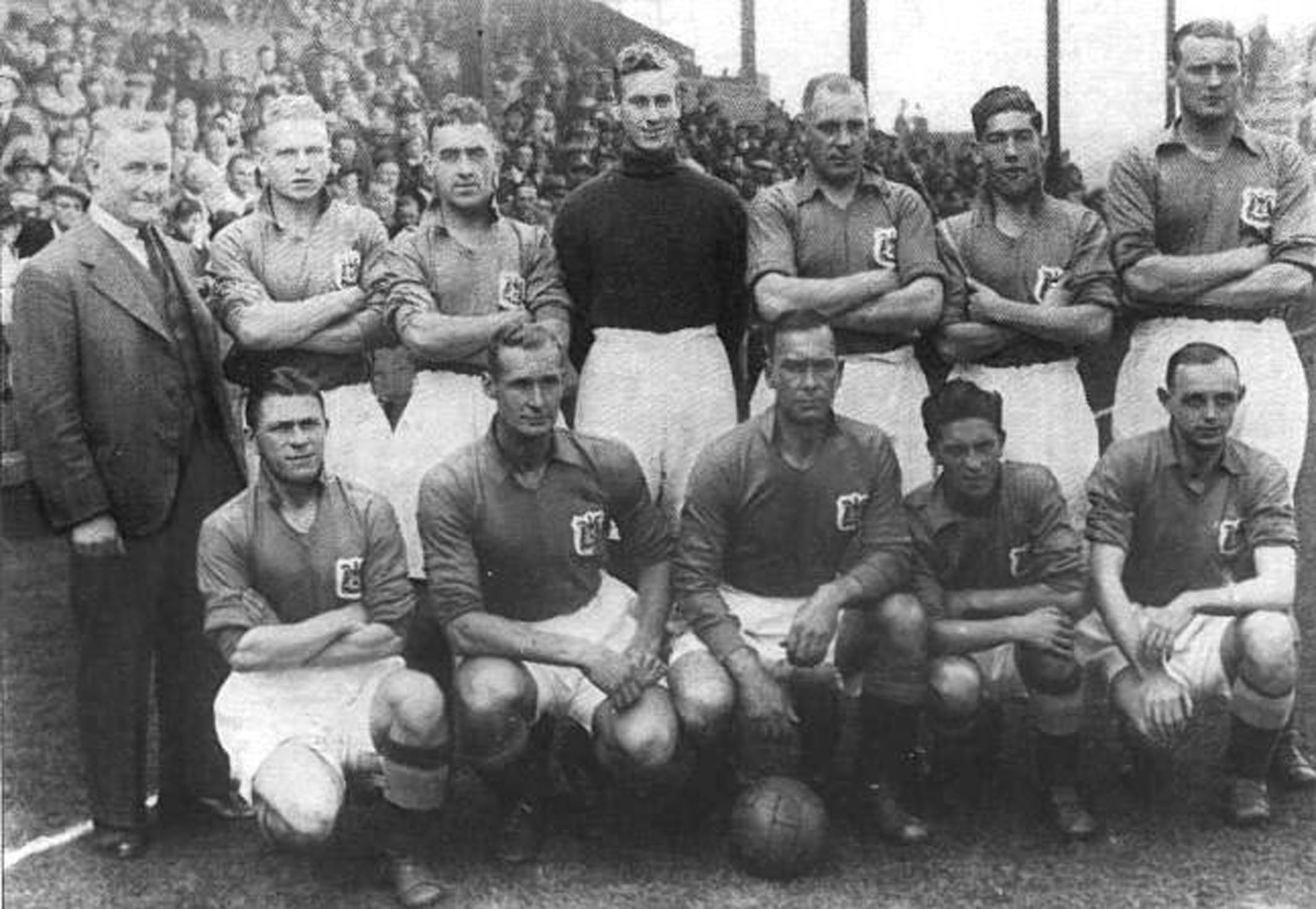
Back Row: Billy Hampson (Manager), Bert Sproston, Jim Makinson, Reg Savage, Jack Milburn, Bobby Browne, Tom Holley.
Front Row: Sammy Armes, George Ainsley, Gordon Hodgson, Eric Stephenson, Arthur Buckley.
1937-38 (Courtesy of Paul Gregson)
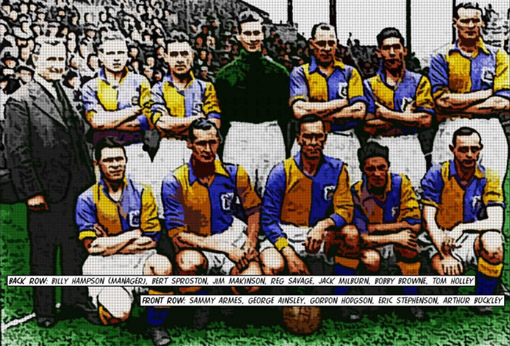
Back Row: Billy Hampson (Manager), Bert Sproston, Jim Makinson, Reg Savage, Jack Milburn, Bobby Browne, Tom Holley.
Front Row: Sammy Armes, George Ainsley, Gordon Hodgson, Eric Stephenson, Arthur Buckley.
1937-38
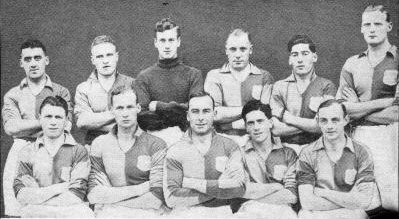
Back Row: Jim Makinson, Bert Sproston, Reg Savage, Jack Milburn, Bobby Browne, Tom Holley.
Front Row: Sammy Armes, George Ainsley, Gordon Hodgson, Eric Stephenson, Arthur Buckley.
1937-38
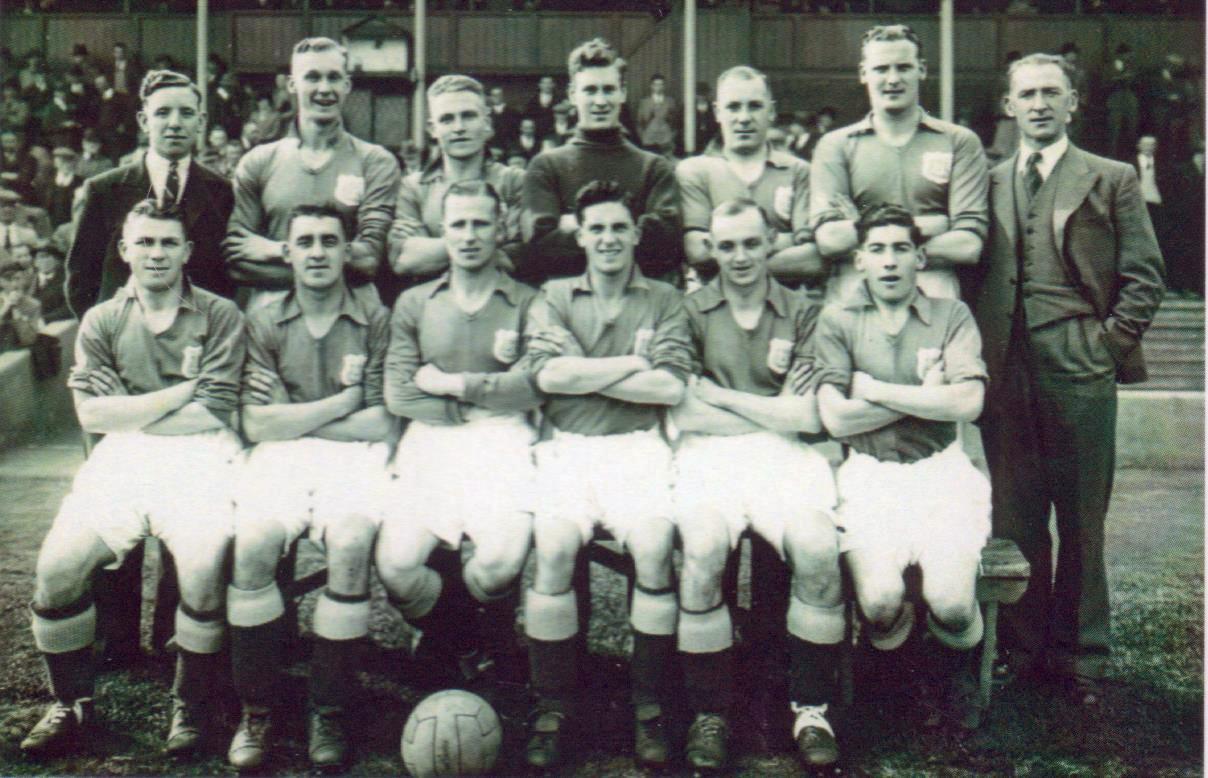
Back Row: Tom Hampson, George Ainsley, Bert Sproston, Reg Savage, Jack Milburn, Tom Holley, Bob Roxburgh (Trainer).
Front Row: Sammy Armes, Jim Makinson, Jack Kelly, Eric Stephenson, Arthur Buckley, Bobby Browne.
1937-38
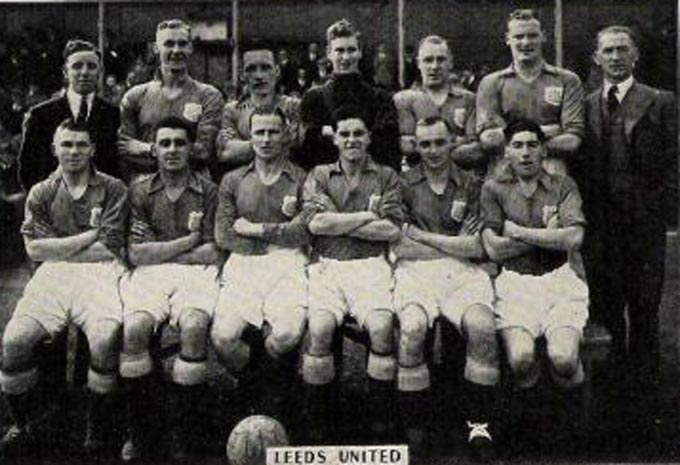
Back Row: Tom Hampson, George Ainsley, Bob Kane, Reg Savage, Jack Milburn, Tom Holley, Bob Roxburgh (Trainer).
Front Row: Sammy Armes, Jim Makinson, Jack Kelly, Eric Stephenson, Arthur Buckley, Bobby Browne.
1937-38
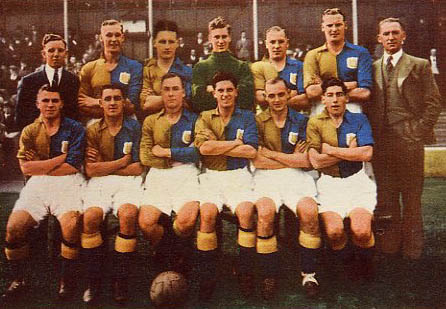
Back Row: Tom Hampson, George Ainsley, Bob Kane, Reg Savage, Jack Milburn, Tom Holley, Bob Roxburgh (Trainer).
Front Row: Sammy Armes, Jim Makinson, Gordon Hodgson, Eric Stephenson, Arthur Buckley, Bobby Browne.
1938-39
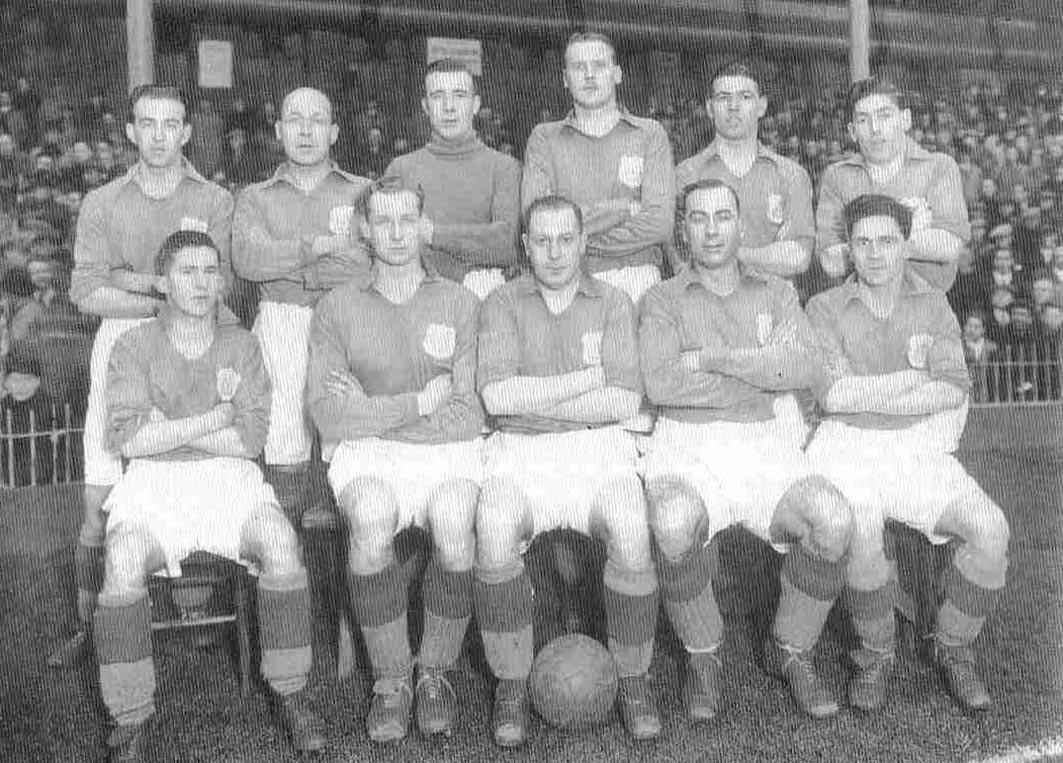
Back Row: Jack Hargreaves, Willis Edwards, Jim Twomey, Tom Holley, Ken Gadsby, Bobby Browne.
Front Row: David Cochrane, George Ainsley, Jack Milburn, Gordon Hodgson, Eric Stephenson.
1938-39(Courtesy of Paul Gregson)
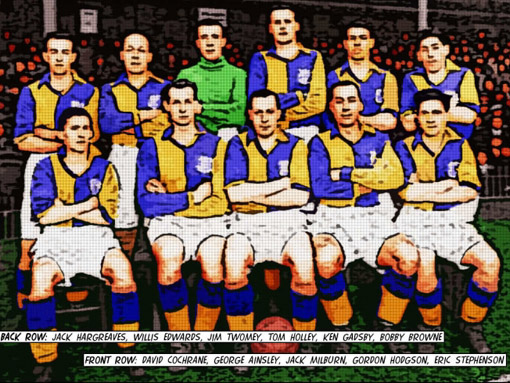
Back Row: Jack Hargreaves, Willis Edwards, Jim Twomey, Tom Holley, Ken Gadsby, Bobby Browne.
Front Row: David Cochrane, George Ainsley, Jack Milburn, Gordon Hodgson, Eric Stephenson.
Players/Managers:
Dick Ray (Manager), Billy Hampson (Manager), Robert Abel , George Ainsley , Tom Alderson , Sammy Armes , Willie Bennett , George Brown , Vic Brown , Bobby Browne , Arthur Buckley , Jimmy Carr , Davie Cochrane , Tom Cochrane , Wilf Copping , Jack Daniels , Harry Duggan , Bob Danskin , Len Dunderdale , Willis Edwards , Joe Firth , Alan Fowler , Cliff Francis , Billy Furness , Ken Gadsby , Les Goldberg , Harry Green , Tom Hampson , Jack Hargreaves , Ernie Hart , Gerry Henry , Gordon Hodgson , Tom Holley , Cyril Hornby , Arthur Hydes , Bob Kane , Charlie Keetley , Dominic Kelly , Jack Kelly , Mick Kelly , Tom Jennings , Bill Johnson , Eric Longden , Jack Mahon , James Makinson , Jock McDougall , Albert McInroy , Bill Menzies , George Milburn , Jack Milburn , Jim Milburn , Fred Mills , Tom Mitchell , Stan Moore , Tom Neal , Harry O'Grady , Bill Parry , Jimmy Potts , Aubrey Powell , Harry Roberts , Harry Roper , Reg Savage , George Scaife , Bert Sproston , Alec Stacey , Eric Stephenson , Harry Sutherland , John Thomson , Tom Townsley , Jack Trainor , Bobby Turnbull , Charlie Turner , John Turner , Jim Twomey , Ben Underwood , Russell Wainscoat , Norman Wharton , Stan Wilcockson , Charlie Wilkinson , Bert Worsley .